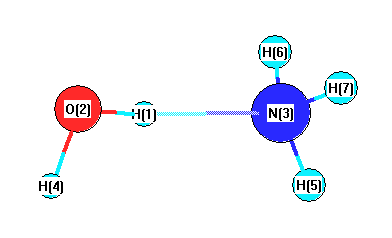Vibrational Frequencies calculated at CCSD(T)/6-31+G**
| Mode Number |
Symmetry |
Frequency
(cm-1) |
Scaled Frequency
(cm-1) |
IR Intensities
(km mol-1) |
Raman Act
(Å4/u) |
Dep P |
Dep U |
|---|
| 1 |
A' |
3944 |
3785 |
|
|
|
|
| 2 |
A' |
3701 |
3551 |
|
|
|
|
| 3 |
A' |
3663 |
3515 |
|
|
|
|
| 4 |
A' |
3519 |
3377 |
|
|
|
|
| 5 |
A' |
1701 |
1632 |
|
|
|
|
| 6 |
A' |
1691 |
1623 |
|
|
|
|
| 7 |
A' |
1156 |
1109 |
|
|
|
|
| 8 |
A' |
467 |
448 |
|
|
|
|
| 9 |
A' |
219 |
210 |
|
|
|
|
| 10 |
A' |
185 |
177 |
|
|
|
|
| 11 |
A" |
3663 |
3515 |
|
|
|
|
| 12 |
A" |
1697 |
1629 |
|
|
|
|
| 13 |
A" |
739 |
710 |
|
|
|
|
| 14 |
A" |
209 |
200 |
|
|
|
|
| 15 |
A" |
18 |
17 |
|
|
|
|
Unscaled Zero Point Vibrational Energy (zpe) 13285.4 cm
-1
Scaled (by 0.9596) Zero Point Vibrational Energy (zpe) 12748.7 cm
-1
See section
III.C.1 List or set vibrational scaling factors
to change the scale factors used here.
See section
III.C.2
Calculate a vibrational scaling factor for a given set of molecules
to determine the least squares best scaling factor.
Charges, Dipole, Quadrupole and Polarizability
Charges from optimized geometry at CCSD(T)/6-31+G**
Charges (e)
| Number |
Element |
Mulliken |
CHELPG |
AIM |
ESP |
| 1 |
H |
0.459 |
|
|
|
| 2 |
O |
-0.793 |
|
|
|
| 3 |
N |
-0.952 |
|
|
|
| 4 |
H |
0.352 |
|
|
|
| 5 |
H |
0.306 |
|
|
|
| 6 |
H |
0.314 |
|
|
|
| 7 |
H |
0.314 |
|
|
|
Electric dipole moments
Electric dipole components in Debye
(What's a Debye? See section
VII.A.3)
| |
x |
y |
z |
Total |
| |
1.490 |
-3.654 |
0.000 |
3.946 |
| CHELPG |
|
|
|
|
| AIM |
|
|
|
|
| ESP |
|
|
|
|
Electric Quadrupole moment
Quadrupole components in D Å
Polarizabilities
Components of the polarizability tensor.
Units are
Å
3 (Angstrom cubed)
Change units.
| |
x |
y |
z |
| x |
0.000 |
0.000 |
0.000 |
| y |
0.000 |
0.000 |
0.000 |
| z |
0.000 |
0.000 |
0.000 |
<r2> (average value of r
2) Å
2
| <r2> |
0.000 |
| (<r2>)1/2 |
0.000 |
